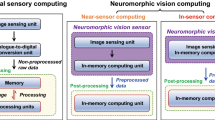Abstract
The interest in tactile sensors is increasing as their use in complex unstructured environments is demanded, like in telepresence, minimal invasive surgery, robotics etc. The array of pressure data provided by these devices can be treated with different image processing algorithms to extract miscellaneous information. However, as in the case of vision chips or artificial retinas, problems arise when the size of the array and the computational complexity increase. Having a look at the skin, the information collected by every mechanoreceptor is not sent to the brain for its processing, but some complex pre-processing is performed to fit the limited throughput of the nervous system. This is specially important for high bandwidth demanding tasks, as the case of slip detection with tactile sensors, which is demanding in computing requirements. Here we show some results from a tactile processor based on circuitry proposed for an artificial retina that has been modified to mimic the way the biological skin works.




















Similar content being viewed by others
Notes
Tactile elements
Ideally, it can be assumed that the scale factors are the same. However, to take into account signal-dependent non-idealities, these scale factors should be considered only similar.
References
Lee, M. H., & Nicholls, H. R. (1999). Tactile sensing for mechatronics-a state of the art survey. Mechatronics, 9, 1–31.
Lee, M. H. (2000). Tactile sensing, new directions, new challenges. The International Journal of Robotics Research, 19(7), 636–643.
Iwashita, A., & Shimojo, M. (2004). Development of a mixed signal LSI for tactile data processing. Proceedings of IEEE International Conference on Systems, Man and Cybernetics, 5, 4408–4413.
Canepa, G., Petrigliano, R., Campanella, M., & De Rossi, D. (1998). Detection of incipient object slippage by skin-like sensing and neural network processing. IEEE Transactions on Systems and Cybernetics, 28(3), 348–356.
Howe, R. D. (1994). Tactile sensing and control of robotic manipulation. Journal of Advanced Robotics, 8, 245–261.
Fujimoto, I., Yamada, Y., Morizono, T., Umetani, Y., & Maeno, T. (2003). Development of artificial finger skin to detect incipient slip for realization of static friction sensation, Proceedings of IEEE Multisensor Fusion and Integration for Intelligent Systems, 15–21.
Stansfield, S. A. (1993). Experiments in robotic sensorimotor control during grasp. IEEE Transactions on Systems, Man and Cybernetics, 23, 891–896.
Howe, R. D., & Cutkosky, M. R. (1989). Sensing skin acceleration for slip and texture perception. Proceedings of IEEE Robotics Automation, 145–150.
Mead, C. (1989). Analog VLSI and neural systems, Addison-Wesley: Reading, MA.
Peine, W. J., & Howe, R. D. (1998). Do humans sense finger deformation or distributed pressure to detect lumps in soft tissue? Proeedings of ASME Dynamic Systems and Control Division, 64, 273–278.
Holweg, E. G. M., Hoeve, H., Jongkind, W., Marconi, L., Melchiorri, C., & Bonivento, C. (1996). Slip detection by tactile sensors: Algorithms and experimental results. Proceedings of IEEE International Conference on Robotics and Automation.
Alessio, T. D. (1999). Measurement errors in the scanning of piezoresistive sensors arrays. Sensors and Actuators, 72, 71–76.
Silva-Martínez, J., & Solís-Bustos, S. (1999). Design considerations for high performance very ow frequency filters. Proceedings of the 1999 IEEE International Symposium on Circuits and Systems, ISCAS’99, 2, 648–651.
Veeravalli, A., Sánchez-Sinencio E., & Silva-Martínez, J. (2002). Transconductance amplifier structures with very small transconductances: A comparative design approach. IEEE Journal of Solid-State Circuits, 37, 770–775.
Rodríguez-Vázquez, A., Delgado-Restituto, M., & Domínguez-Castro, R. (1999). Comparators: Architectures for voltage and current input with CMOS implementation examples. Wiley Encyclopedia of Electrical and Electronics Engineering, 3, 557–600.
Acknowledgments
This work has been partially funded by project TIC2003-09817-C02, and has been motivated from maintained research collaboration between Seville and Málaga.
The authors thank ZOFLEX® for providing samples of pressure-activated conductive rubber sheets.
Author information
Authors and Affiliations
Corresponding author
Rights and permissions
About this article
Cite this article
Maldonado-López, R., Vidal-Verdú, F., Liñán, G. et al. Early slip detection with a tactile sensor based on retina. Analog Integr Circ Sig Process 53, 97–108 (2007). https://doi.org/10.1007/s10470-007-9059-3
Received:
Revised:
Accepted:
Published:
Issue Date:
DOI: https://doi.org/10.1007/s10470-007-9059-3




